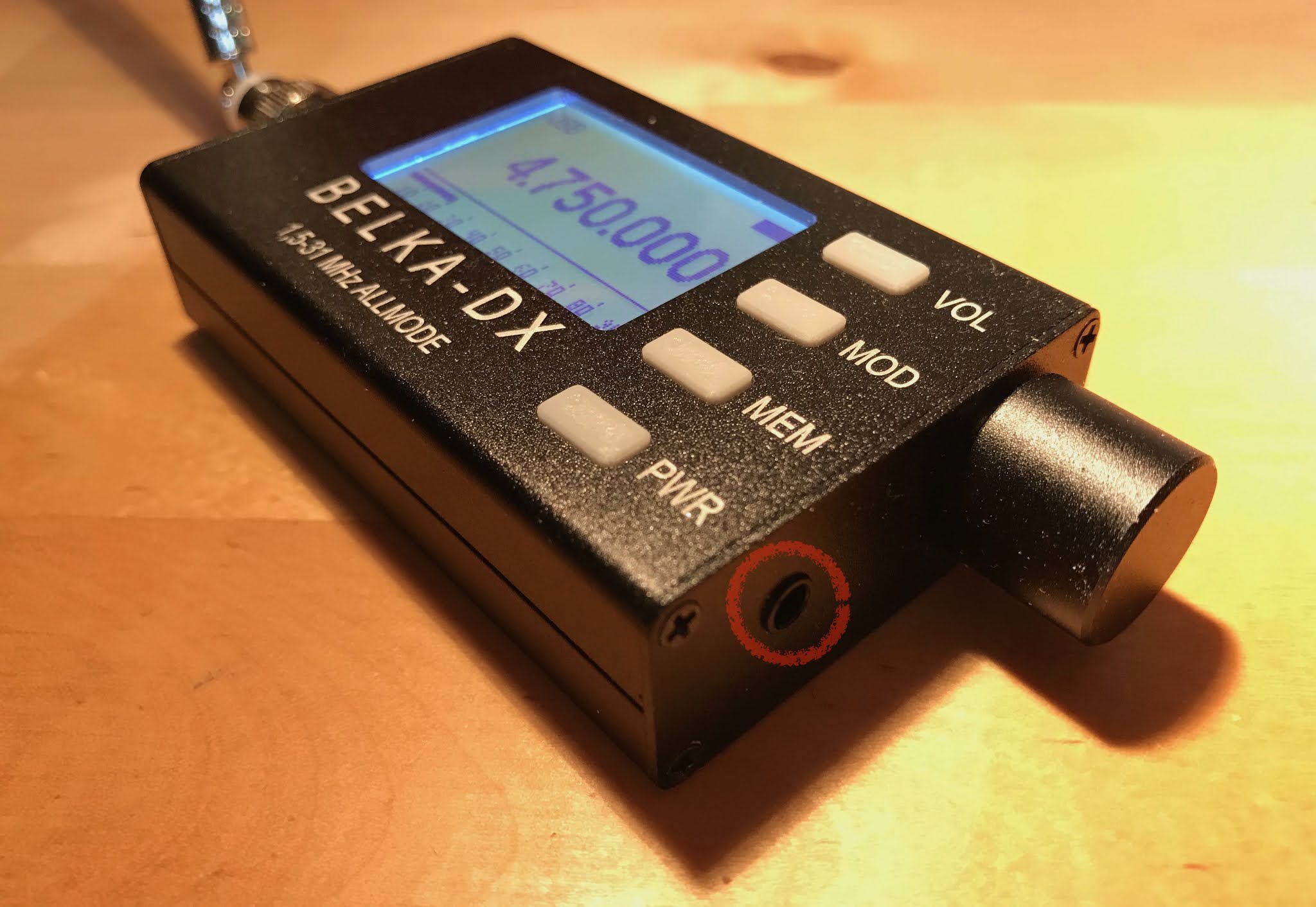This is a quick "how-to" post on making spectrum recordings with the latest model of the ultra-portable Belka shortwave receiver, the Belka-DX. A number of positive reviews of the previous model of this receiver have already been posted online. The new version boasts greater sensitivity, extended shortwave coverage and the ability to monitor I/Q – or radio spectrum – data in real time.
A separate 3.5mm stereo port is used for outputting I/Q data in analogue format. This seems an unusual design choice: nowadays, most SDRs send I/Q data digitally over USB (e.g. see FunCube Dongle Pro+).To get SDR applications to work with this data, Belka's I/Q output needs to be connected to the line input of a regular PC sound card. The digital —> analogue —> digital conversion chain will inevitably result in the addition of small amounts of noise to the final spectrum output. However, one advantage of this design choice is that it is possible to capture this data using a portable audio recorder.
 |
| Belka DX I/Q output port |
While Belka's I/Q sample rate is reportedly 192 kHz, few recorders are capable of capturing audio at this rate (and none of them are cheap or particularly compact), and the 96 kHz option is far more widely available. In practice, recording at this rate means that roughly 48 khz on each side of the centre frequency become truncated, but on shortwave, 96 khz can still pack several broadcast stations (or, alternatively, a few dozen ham radio transmissions). Additionally, DSP tools in SDR applications such as SDR# can be used to clean up I/Q recordings in ways that are far superior to what's possible to achieve with regular post-processing of audio recordings.
I made several field spectrum recordings with my Zoom H1, connecting Belka's I/Q output to the recorder's line input and using the "WAV @ 96 kHz / 16 bit" setting. I found that keeping the input level between -24dB and -12dB results in sufficient gain for later analysis without overloading the recorder.
It's worth noting that the gain and the slight offset from the tuned centre frequency seem to change depending on both the frequency and the chosen demodulation mode.
Results
First up is the Voice of America recording I made on 06/11/20 in a London park. To assess the quality of my I/Q capture method I recorded the audio output in parallel using my Sony ICD-PX333. I set Belka's demodulation mode to "AM2", which is its pseduo-synchronous AM detection setting. Below are the two recordings, with the I/Q data demodulated in SDR#:
Belka's own demodulation is a little on the distorted side compared with SDR#'s I/Q demodulation. This is probably due to the specifics of its "AM2" setting.
Made simultaneous spectrum and audio recordings. Blog post comparing the two coming shortly. cc @SWLingDotCom @lambdaprog https://t.co/PX7h892OLx pic.twitter.com/Ehw0Kr5JW6
— London Shortwave (@LondonShortwave) November 6, 2020
Note that I'm using SDR#'s handy "invert spectrum" and "correct IQ" options, and that I've modified the spectrum recording file names so that the centre frequency is displayed correctly.
Below are two more examples of this I/Q capture method and their audio recording counterparts. For the latter, I set Belka's mode to LSB with 50 Hz lower and 4 kHz upper frequency cutoffs. I also used Youssef's excellent noise reduction plugin when demodulating I/Q.
Radio Rebelde on 12/11/20 at 07:01 UTC
Radio Rebelde was barely registering on Belka's SNR meter but the audio is perfectly intelligible, while SDR#'s noise reduction takes this intelligebility to an entirely new level.
.@radiorebelde_en coming in nicely. 🇨🇺 pic.twitter.com/7yw4FU0fYG
— London Shortwave (@LondonShortwave) November 12, 2020
Radio New Zealand International on 12/11/20 at 08:00
Very clear reception, with SDR#'s I/Q noise reduction providing a marked improvement over Belka's own audio demodulation.
Lovely @RNZPacific signal this morning. ☀️ pic.twitter.com/Jx8h2EqsEZ
— London Shortwave (@LondonShortwave) November 12, 2020
CQ contest on 40m on 21/11/20 at 15:33
Finally, here is a full I/Q capture of a CQ constest on 40m on 21/11/20, recorded in the same park location (click here to download the original WAV file). An Over The Horizon Radar signal makes an unfortunate appearance during the first 20 minutes of the recording, causing severe interference. You will also notice a few hams ignoring the contest altogether and happily rag chewing!
Overall, this is by far my most portable shortwave spectrum capture combo: it is handheld and absolutely no antenna set-up is required – just plug in the supplied telescopic whip and you are good to go. The reduced bandwidth compared to my AirSpy SDRs is a significant limitation, but it was only a few years ago that I was making recordings with a FunCube Dongle Pro+ that only provided double the above sample rate. It would be amazing if Belka's next model included a microSD card slot and the ability to record the I/Q data directly to it, but for now I am very happy with this way of making spectrum recordings on the move.























4 comments: